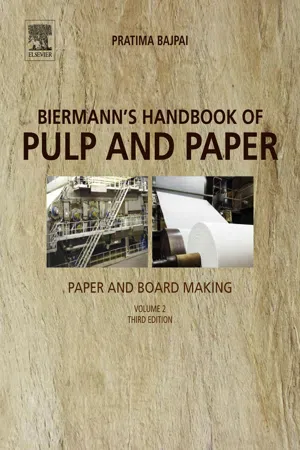
- 576 pages
- English
- ePUB (mobile friendly)
- Available on iOS & Android
About this book
Biermann's Handbook of Pulp and Paper: Paper and Board Making, Third Edition provides a thorough introduction to paper and board making, providing paper technologists recent information. The book emphasizes principles and concepts behind papermaking, detailing both the physical and chemical processes. It has been updated, revised and extended. Several new chapters have been added. Papermaking chemistry has found an adequate scope covering this important area by basics and practical application. Scientific and technical advances in refining, including the latest developments have been presented. The process of stock preparation describes the unit processes. An exhaustive overview of Chemical additives in Pulp and Paper Industry is included. Paper and pulp processing and additive chemicals are an integral part of the total papermaking process from pulp slurry, through sheet formation, to effluent disposal. Water circuits with loop designs and circuit closure are presented. The chapter on paper and board manufacture covers the different sections in the paper machine and also fabrics, rolls and roll covers, and describes the different types of machines producing the various paper and board grades. Coating is dealt with in a separate chapter covering color formulation and preparation and also coating application. Paper finishing gives an insight into what happens at roll slitting and handling. The chapter on environmental impact includes waste water treatment and handling, air emissions, utilization and solid residue generation and mitigation. The major paper and board grades and their properties, are described. Biotechnological methods for paper processing are also presented. This handbook is essential reading for Applied Chemists, Foresters, Chemical Engineers, Wood Scientists, and Pulp and Paper technologist/ Engineers, and anyone else interested or involved in the pulp and paper industry.- Provides comprehensive coverage on all aspects of papermaking- Covers the latest science and technology in papermaking- Includes traditional and biotechnological methods, a unique feature of this book- Presents the environmental impact of papermaking industries- Sets itself apart as a valuable reference that every pulp and papermaker/engineer/chemist will find extremely useful
Frequently asked questions
- Essential is ideal for learners and professionals who enjoy exploring a wide range of subjects. Access the Essential Library with 800,000+ trusted titles and best-sellers across business, personal growth, and the humanities. Includes unlimited reading time and Standard Read Aloud voice.
- Complete: Perfect for advanced learners and researchers needing full, unrestricted access. Unlock 1.4M+ books across hundreds of subjects, including academic and specialized titles. The Complete Plan also includes advanced features like Premium Read Aloud and Research Assistant.
Please note we cannot support devices running on iOS 13 and Android 7 or earlier. Learn more about using the app.
Information
Refining and Pulp Characterization
Abstract
Keywords
1.1. Introduction to Refining
Fiber Brushing
Table of contents
- Cover image
- Title page
- Table of Contents
- Copyright
- Dedication
- Preface to the Third Edition
- Preface to the Second Edition
- Preface to the First Edition
- Acknowledgments
- Abbreviations
- Chapter 1. Refining and Pulp Characterization
- Chapter 2. Paper and Its Properties
- Chapter 3. Stock Preparation
- Chapter 4. Additives for Papermaking
- Chapter 5. Paper Manufacture—Wet End Operation
- Chapter 6. Paper Manufacture—Dry End Operation
- Chapter 7. Coating
- Chapter 8. Paper and Board Grades
- Chapter 9. Paper Bioprocessing
- Chapter 10. Papermaking Chemistry
- Chapter 11. Optical Properties of Paper
- Chapter 12. Corrugated Containers
- Chapter 13. Printing and Graphic Arts
- Chapter 14. Water Circuits in Paper Mill
- Chapter 15. Environmental Impact
- Chapter 16. Metric and English Units and Unit Analysis
- Chapter 17. Carbohydrate Chemistry
- Chapter 18. Polymer Chemistry
- Chapter 19. Colloid and Surface Chemistry
- Chapter 20. Introductory Chemistry Reviews
- Chapter 21. Analytical and Coordinate Chemistry
- Chapter 22. Total Quality Management
- Chapter 23. Hydraulics
- Chapter 24. Process Control
- Chapter 25. Miscellaneous Topics
- Chapter 26. Updates and Bibliography
- Index